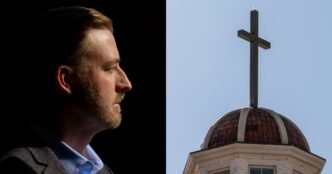At the heart of the religious school case and others like it is the Constitution’s First Amendment — and two provisions about freedom of religion that are in tension with each other. They are the establishment clause, which forbids the government from endorsing one religion over another or setting up its own church, and the free exercise clause, which says everyone has a right to express their own religious beliefs.
Generations of children were taught in school about how Thomas Jefferson said in an 1802 letter that there is “a wall of separation between church and state.” In the past, the Supreme Court interpreted that sentiment broadly, and government officials, including those running public schools, followed suit. Any actions that could potentially be interpreted as a sign that the government endorsed religion were largely off-limits.
Now, the religious school case from Oklahoma could change the longtime understanding of the First Amendment throughout the U.S.
Walters and others like him believe that the Supreme Court got it wrong in the past. They point out that the First Amendment itself says nothing about a “wall of separation” and focus more on their rights under the free exercise clause.
As for the Supreme Court, it now has a 6-3 conservative majority that strongly favors religious rights and in a series of recent decisions has strengthened the free exercise clause, sometimes at the expense of the establishment clause.













